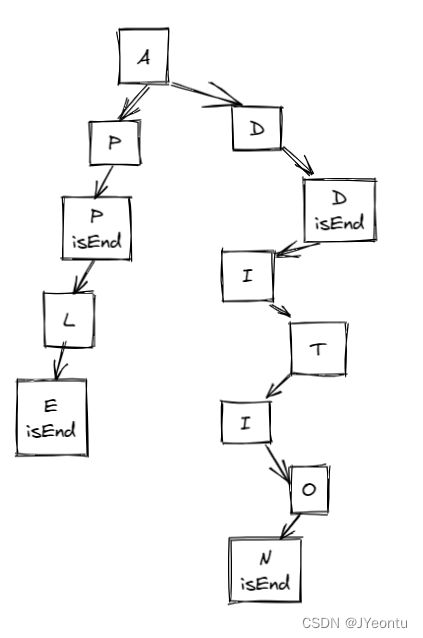单词的压缩编码(后缀树的使用)
说在前面
后缀树(suffix tree)是一种数据结构,通常用于字符串处理。后缀树可以快速找到一个字符串所有的子串,因此在文本搜索、字符串匹配等领域有广泛应用。
后缀树的构建过程是将一个字符串的所有后缀插入到一棵树中。这个树满足以下性质:
根节点代表空字符串。
每个非根节点都表示一个非空字符串的后缀。
从根节点到叶子节点的路径表示一个原始字符串的后缀。
由于每个节点都代表了一个字符串的后缀,因此可以在后缀树上很容易地查找一个字符串的所有子串,只需要找到以该字符串为前缀的所有路径即可。
构建后缀树的时间复杂度为O(n),其中n是字符串的长度,因此后缀树是一种高效的字符串处理数据结构。
题目描述
单词数组 words 的 有效编码 由任意助记字符串 s 和下标数组 indices 组成,且满足:
words.length == indices.length
助记字符串 s 以 ‘#’ 字符结尾
对于每个下标 indices[i] ,s 的一个从 indices[i] 开始、到下一个 ‘#’ 字符结束(但不包括 ‘#’)的 子字符串 恰好与 words[i] 相等
给你一个单词数组 words ,返回成功对 words 进行编码的最小助记字符串 s 的长度 。
示例 1:
输入:words = ["time", "me", "bell"]
输出:10
解释:一组有效编码为 s = "time#bell#" 和 indices = [0, 2, 5] 。
words[0] = "time" ,s 开始于 indices[0] = 0 到下一个 '#' 结束的子字符串,如加粗部分所示 "time#bell#"
words[1] = "me" ,s 开始于 indices[1] = 2 到下一个 '#' 结束的子字符串,如加粗部分所示 "time#bell#"
words[2] = "bell" ,s 开始于 indices[2] = 5 到下一个 '#' 结束的子字符串,如加粗部分所示 "time#bell#"
示例 2:
输入:words = ["t"]
输出:2
解释:一组有效编码为 s = "t#" 和 indices = [0] 。
提示:
1 <= words.length <= 2000
1 <= words[i].length <= 7
words[i] 仅由小写字母组成
思路分析
通过题目描述我们可以知道这道题是需要我们将多个单词通过#号来辅助标识然后进行压缩。如s = "time#bell#" 和 indices = [0, 2, 5] 可以表示["time", "me", "bell"]这三个单词。
简单分析一下这个例子,我们可以发现’time’和’me’有相同的后缀’me’,所以可以将’time’和’me’结合起来,即’time’可以同时表示’time’和’me’这两个单词。所以这道题我们可以使用后缀树的思想来解题,后缀树的本质其实和前缀树是一样的,我们将单词翻转过来进行记录的前缀树就变成后缀树了,那么前缀树又是什么呢?
前缀树
前缀树又称单词查找树,Trie树,是一种树形结构,是一种哈希树的变种。典型应用是用于统计,排序和保存大量的字符串(但不仅限于字符串),所以经常被搜索引擎系统用于文本词频统计。它的优点是:利用字符串的公共前缀来减少查询时间,最大限度地减少无谓的字符串比较,查询效率比哈希树高。
它有3个基本性质:根节点不包含字符,除根节点外每一个节点都只包含一个字符; 从根节点到某一节点,路径上经过的字符连接起来,为该节点对应的字符串; 每个节点的所有子节点包含的字符都不相同。
前缀树本质就是一种树结构,每一个节点存放一个字母,并连接下一个字母,这样多个字母连接起来就是一个完整的单词了,如下图所示:

上图即为一个简单的字典树结构,图中总共包含4个单词,分别为app、apple、add、addition。将上图结构转为json格式数据如下。
{
a:{
p:{
p:{
isEnd: true
l:{
e:{
isEnd:true
}
}
}
},
d:{
d:{
isEnd:true,
i:{
t:{
i:{
o:{
n:{
isEnd:true
}
}
}
}
}
}
}
}
}
javascript实现前缀树结构
/**
* Initialize your data structure here.
*/
//声明结构体
var Trie = function() {
this.tree = {};
};
/**
* Inserts a word into the trie.
* @param {string} word
* @return {void}
*/
//实现数据插入方法
Trie.prototype.insert = function(word) {
let tree = this.tree;
for(const w of word){
if(tree[w] == undefined){
tree[w] = {};
}
tree = tree[w];
}
tree.isEnd = true;
};
/**
* Returns if the word is in the trie.
* @param {string} word
* @return {boolean}
*/
//数据检索方法
Trie.prototype.search = function(word) {
let tree = this.tree;
for(const w of word){
if(tree[w] == undefined){
return false;
}
tree = tree[w];
}
return tree.isEnd == true;
};
/**
* Returns if there is any word in the trie that starts with the given prefix.
* @param {string} prefix
* @return {boolean}
*/
//检索是否存在该前缀组成的单词
Trie.prototype.startsWith = function(prefix) {
let tree = this.tree;
for(const w of prefix){
if(tree[w] == undefined){
return false;
}
tree = tree[w];
}
return true;
};
/**
* Your Trie object will be instantiated and called as such:
* var obj = new Trie()
* obj.insert(word)
* var param_2 = obj.search(word)
* var param_3 = obj.startsWith(prefix)
*/
AC代码
回归到本题目中来,我们可以这样做:
- 定义后缀树类
insert 方法中在每个单词的结尾加上一个属性wordLen来记录该单词的完整长度。
getNum 方法是为题目编写的一个方法,计算最少需要的字符数。
class trimTree{
constructor(){
this.tree = {};
};
insert(word){
let tree = this.tree;
let wordLen = 0;
for(let i = word.length - 1; i >= 0; i--){
const w = word[i];
!tree[w] ? tree[w] = {} : '';
tree = tree[w];
wordLen++;
}
tree.isStart = true;
tree.wordLen = wordLen;
};
getNum(t = this.tree,num = 0){
if(!t) return;
for(let k in t){
if(k === 'wordLen' && Object.keys(t).length == 2){
num += t[k] + 1;
}else if(k !== 'isStart') num += this.getNum(t[k]);
}
return num;
}
}
- 构建后缀树
const tree = new trimTree();
for(const word of words){
tree.insert(word);
}
完整代码如下
/**
* @param {string[]} words
* @return {number}
*/
var minimumLengthEncoding = function(words) {
const tree = new trimTree();
for(const word of words){
tree.insert(word);
}
return tree.getNum();
};
class trimTree{
constructor(){
this.tree = {};
};
insert(word){
let tree = this.tree;
let wordLen = 0;
for(let i = word.length - 1; i >= 0; i--){
const w = word[i];
!tree[w] ? tree[w] = {} : '';
tree = tree[w];
wordLen++;
}
tree.isStart = true;
tree.wordLen = wordLen;
};
getNum(t = this.tree,num = 0){
if(!t) return;
for(let k in t){
if(k === 'wordLen' && Object.keys(t).length == 2){
num += t[k] + 1;
}else if(k !== 'isStart') num += this.getNum(t[k]);
}
return num;
}
}
公众号
关注公众号『前端也能这么有趣』,获取更多新鲜内容。
说在后面
这里是 JYeontu,现在是一名前端工程师,有空会刷刷算法题,平时喜欢打羽毛球 ,平时也喜欢写些东西,既为自己记录 ,也希望可以对大家有那么一丢丢的帮助,写的不好望多多谅解 ,写错的地方望指出,定会认真改进 ,偶尔也会在自己的公众号『
前端也能这么有趣』发一些比较有趣的文章,有兴趣的也可以关注下。在此谢谢大家的支持,我们下文再见 。